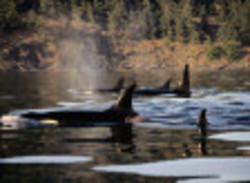
Image Credit: Huffington Post Images
Imagine spending 24 hours a day, 7 days a week, 365 days a year with your family members. Your brothers and sisters, your aunts and uncles, your grandmother, your children. Imagine holding their hands, rubbing their backs, sharing all of your meals. When you sleep, you hear each other breathing, and when you wake you socialize, spending every one of life's moments together.
Now, imagine that your family is torn apart, individual by individual. Imagine that you and your family are slowly starving to death despite all your best efforts to search for food.
There is a group of killer whales, the Southern Residents. They live in the Pacific Northwest. Their lives are increasingly difficult every day of every year. Their survival is tenuous because the vast majority of their food, the Chinook Salmon, have all but disappeared.
This group of killer whales, the SRKW, are a highly endangered population now down to 80 individuals; few of which are reproductive females.
Because many of the reproductive females were removed from this population in the 1970s to fill amusement parks, including Seaworld, the Miami Seaquarium, who still houses Lolita the SRKW today, and others such as SeaLand and Marineland.
Unfortunately, for those who are of reproductive age, success is in short supply. Still-births, low fecundity, and early post-natal deaths likely related to toxicity and starvation are at play.
Apex predators such as dolphins and orca are highly toxic, accumulating years of persistent organic pollutants in their fat and blubber. The fish they eat are laden with mercury, DDT, PCBs, and BPA from plastic trash, chemical runoff, and other pollutants in the oceans.
During times of plenty, they store these toxins in their blubber. But, during lean times, such as during the last several years, they mobilize these toxins, which are dangerous to the whales themselves, and to their vulnerable offspring.
Something can be done to help the SRKW's situation. There is a lack of Chinook salmon in the area because of dams which prevent the salmon from reaching their spawning grounds. One set of dams in particular, the Snake River Dams have a proposal to be torn down. The proposal is sound and will allow Chinook salmon to come back into the area. Good for the salmon and especially good for the endangered orcas.
Per usual, it is politics and political will that are preventing this from occurring now. The time and energy that is wasted deliberating whether or not to breach this damn is costing these whales their lives.
This special group of whales is protected by the Endangered Species Act, and yet, humans are facilitating their extinction.
The amusement parks named above all facilitated the destruction of this population of whales when they took 40 to 50 of these individuals into their parks.
Now, they sit back quietly, ignoring the problem.
So I ask again, can you imagine spending 24 hours a day, 7 days a week, 365 days a year with your family members, only to see them suffer a slow, painful death from starvation? Can you imagine not waking up next to your child tomorrow? If the answer is no, then help fight for these orca's lives, and contact Governor Inslee of Washington State through their "contact us" form, or call at this number: 360-902-4111. Tell him to breach those dams!
Our 2024 Coverage Needs You
It's Another Trump-Biden Showdown — And We Need Your Help
The Future Of Democracy Is At Stake
Our 2024 Coverage Needs You
Your Loyalty Means The World To Us
As Americans head to the polls in 2024, the very future of our country is at stake. At HuffPost, we believe that a free press is critical to creating well-informed voters. That's why our journalism is free for everyone, even though other newsrooms retreat behind expensive paywalls.
Our journalists will continue to cover the twists and turns during this historic presidential election. With your help, we'll bring you hard-hitting investigations, well-researched analysis and timely takes you can't find elsewhere. Reporting in this current political climate is a responsibility we do not take lightly, and we thank you for your support.
Contribute as little as $2 to keep our news free for all.
Can't afford to donate? Support HuffPost by creating a free account and log in while you read.
The 2024 election is heating up, and women's rights, health care, voting rights, and the very future of democracy are all at stake. Donald Trump will face Joe Biden in the most consequential vote of our time. And HuffPost will be there, covering every twist and turn. America's future hangs in the balance. Would you consider contributing to support our journalism and keep it free for all during this critical season?
HuffPost believes news should be accessible to everyone, regardless of their ability to pay for it. We rely on readers like you to help fund our work. Any contribution you can make — even as little as $2 — goes directly toward supporting the impactful journalism that we will continue to produce this year. Thank you for being part of our story.
Can't afford to donate? Support HuffPost by creating a free account and log in while you read.
It's official: Donald Trump will face Joe Biden this fall in the presidential election. As we face the most consequential presidential election of our time, HuffPost is committed to bringing you up-to-date, accurate news about the 2024 race. While other outlets have retreated behind paywalls, you can trust our news will stay free.
But we can't do it without your help. Reader funding is one of the key ways we support our newsroom. Would you consider making a donation to help fund our news during this critical time? Your contributions are vital to supporting a free press.
Contribute as little as $2 to keep our journalism free and accessible to all.
Can't afford to donate? Support HuffPost by creating a free account and log in while you read.
As Americans head to the polls in 2024, the very future of our country is at stake. At HuffPost, we believe that a free press is critical to creating well-informed voters. That's why our journalism is free for everyone, even though other newsrooms retreat behind expensive paywalls.
Our journalists will continue to cover the twists and turns during this historic presidential election. With your help, we'll bring you hard-hitting investigations, well-researched analysis and timely takes you can't find elsewhere. Reporting in this current political climate is a responsibility we do not take lightly, and we thank you for your support.
Contribute as little as $2 to keep our news free for all.
Can't afford to donate? Support HuffPost by creating a free account and log in while you read.
Dear HuffPost Reader
Thank you for your past contribution to HuffPost. We are sincerely grateful for readers like you who help us ensure that we can keep our journalism free for everyone.
The stakes are high this year, and our 2024 coverage could use continued support. Would you consider becoming a regular HuffPost contributor?
Dear HuffPost Reader
Thank you for your past contribution to HuffPost. We are sincerely grateful for readers like you who help us ensure that we can keep our journalism free for everyone.
The stakes are high this year, and our 2024 coverage could use continued support. If circumstances have changed since you last contributed, we hope you'll consider contributing to HuffPost once more.
Already contributed? Log in to hide these messages.

